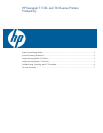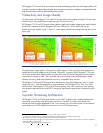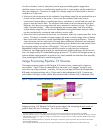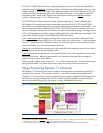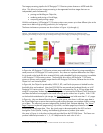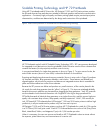
5
The image processing pipeline for HP Designjet T1100-series printers features a 40GB hard disk
drive. This allows in-printer image processing to be segmented into three stages that can run
independently and simultaneously:
• parsing and building an Object List;
• rendering and storing a Virtual Page;
• composing and printing a page.
With this architecture, HP Designjet T1100-series printers can process up to three different jobs at the
same time to deliver high printing productivity for workgroups.
The three simultaneous processes are shown below in Figure 4 (a) through (c).
Figure 4. Three Simultaneous Processes in the Image Processing Pipeline for HP Designjet T1100-series Printers:
(a) parsing and building an Object List; (b) rendering and storing a Virtual Page; (c) composing and printing a page
In Figure 4a, HP Designjet T1100-series printers parse and build an Object List using essentially the
same process as HP Designjet T610-series printers. But, there are important differences: the Object
List is stored on the hard disk drive instead of RAM, and embedded PostScript processing is available
in HP Designjet T1100ps-series printers. The hard disk drive allows HP Designjet T1100-series
printers to process more complex pages than the HP Designjet T610-series, because the size of the
Object List is not limited by RAM.
In Figure 4b, the Object List produced by HP-GL/2, RTL, and PostScript parsers is fetched from the
hard disk drive and rendered. Note that PCL3GUI files are parsed and rendered directly as in HP
Designjet T610-series printers. The Virtual Page Storer
compresses the 24- or 32 bpp image data
using HP’s proprietary lossless algorithm. This algorithm is optimized for RGB and CMYK continuous-
tone data and allows more pages to be stored in the job queue without loss of quality. With 11GB
on the hard drive dedicated to job storage, the Virtual Page Store
can hold more than 11 A1 pages.
In Figure 4c, jobs are released from the top of the print queue when there is sufficient page data in
the Virtual Page Store to ensure that composing and printing the page can complete without running
out of data. This effectively prevents image quality problems from wait-state banding. The Virtual
Page Composer implements page nesting, crop marks, and other page layout features on the
compressed (virtual) page data. Then, the virtual page is decompressed by the ASIC and sent
through the Color Pipeline, Scaling, and Halftoning processes to produce print masks.
Also seen in Figure 4c is the direct writing path provided from the PCL3GUI Parser. The Parser can
produce halftoned print masks in 1-, 2-, or 4 bbp formats for each color of ink.
12
12
In this case, “N-channel” data shown in Figure 4c means 6-channels: one for each color printhead.



